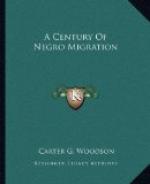In the formation of the States of Indiana and Illinois the question as to what should be done to harmonize with the new constitution the system of indenture to which the territorial legislatures had been committed, caused heated debate and at times almost conflict. Both Indiana[25] and Illinois[26] finally incorporated into their constitutions compromise provisions for a nominal prohibition of slavery modified by clauses for the continuation of the system of indentured labor of the Negroes held to service. The proslavery party persistently struggled for some years to secure by the interpretation of the laws, by legislation and even by amending the constitution so to change the fundamental law as to provide for actual slavery. These States, however, gradually worked toward freedom in keeping with the spirit of the majority who framed the constitution, despite the fact that the indenture system in southern Illinois and especially in Indiana was at times tantamount to slavery as it was practiced in parts of the South.
It must be borne in mind here, however, that the North at this time was far from becoming a place of refuge for Negroes. In the first place, the industrial revolution had not then had time to reduce the Negroes to the plane of beasts in the cotton kingdom. The rigorous climate and the industries of the northern people, moreover, were not inviting to the blacks and the development of the carrying trade and the rise of manufacturing there did not make that section more attractive to unskilled labor. Furthermore, when we consider the fact that there were many thousands of Negroes in the Southern States the presence of a few in the North must be regarded as insignificant. This paucity of blacks then obtained especially in the Northwest Territory, for its French inhabitants instead of being an exploiting people were pioneering, having little use for slaves in carrying out their policy of merely holding the country for France.




